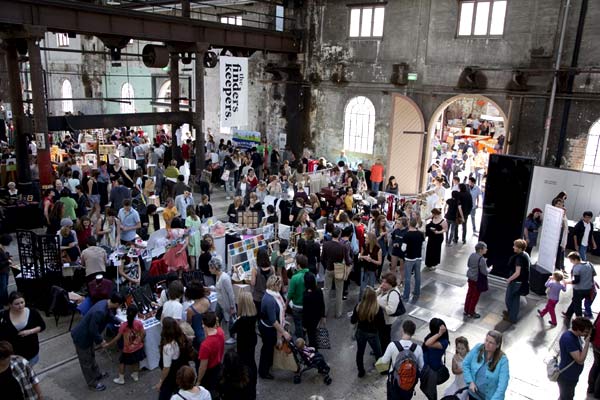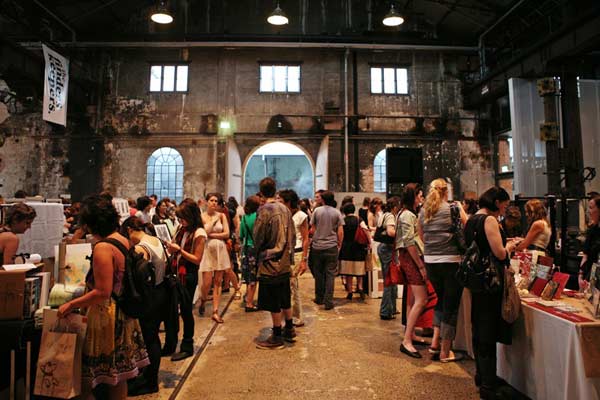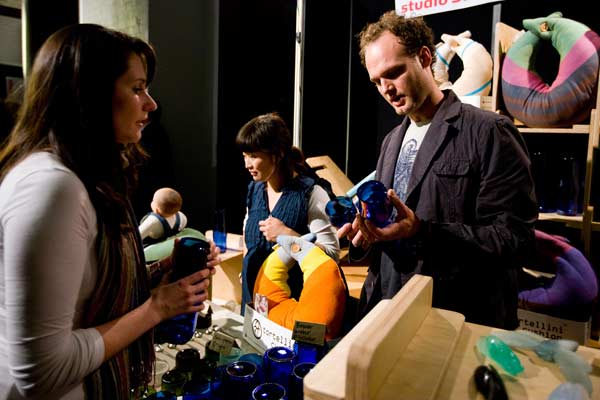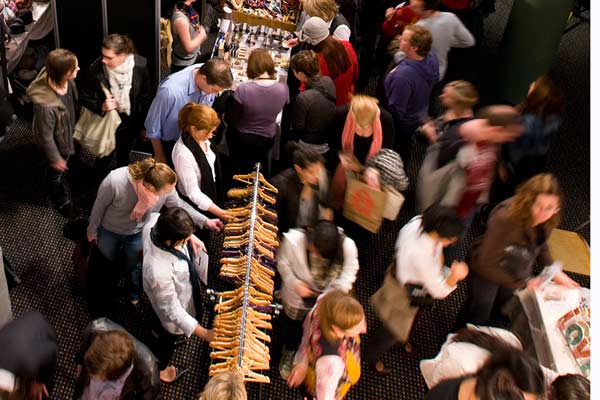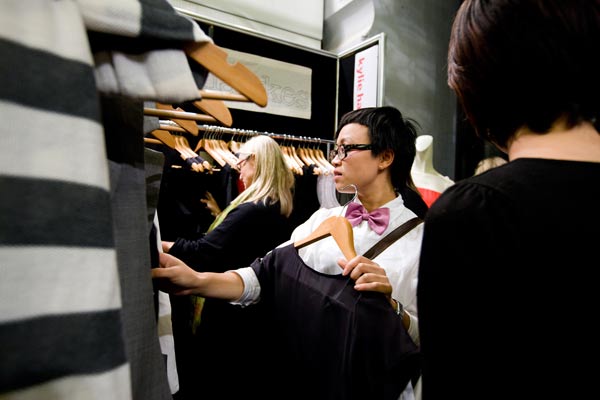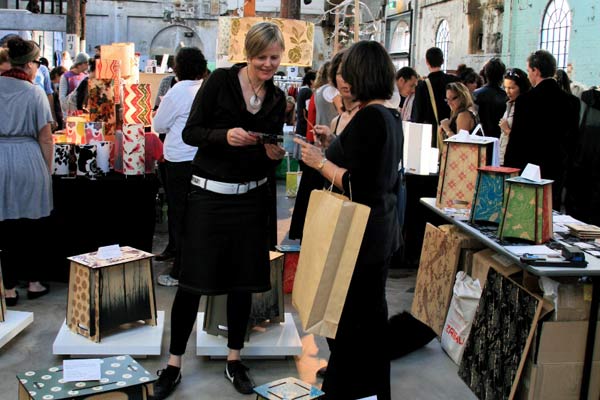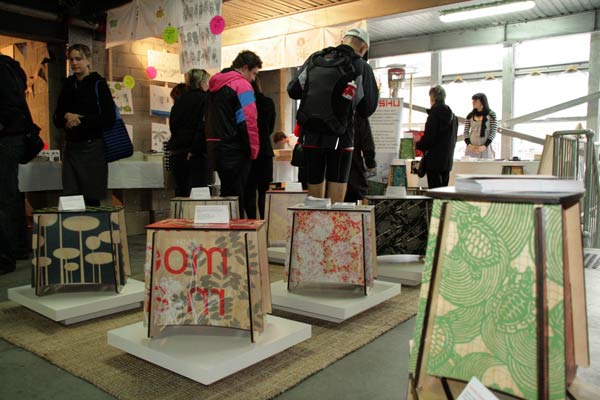To market, to market
This year Australia found itself in the middle of design market frenzy with new craft and design marketplaces popping up all over the country or established markets setting up their events in new cities. Leading up to Christmas this year there are close to thirty craft and design markets being held across Australia. But design markets are not necessarily the right step for all designers.
Here we speak with market organisers and designers across Australia to assess the pros and cons of market retailing.
The marketplace
When Melbourne-based designer Andrew Ashton of Pip and Co. first proposed holding a market focused on Australian design in 2003, the response he received was lukewarm.
‘I was doing the marketing for Swinburne University at the time and I suggested they do a design market. It was enthusiastically taken up by some of the management team but most thought it was just too daggy.’
A few months later Andrew took the concept to the inaugural State of Design festival in Victoria, and now six years on, the Melbourne Design Market is one of that state’s biggest and most popular annual design events drawing a crowd of over 15,000 in one day.
The continued success of the Melbourne Design Market and other boutique design events, including Magnolia Square, the Young Blood Designers Market and The Finders Keepers in Sydney, have strongly contributed to the shift in the perception of design and craft in Australia. For the general consumer emerging and established designers and makers have developed a unified presence and a growing competitive edge alongside their international peers.
Going to market
There are many reasons markets have become an attractive arena for design businesses in Australia and around the world. Young designers establishing their careers often use markets to launch their brand, build a profile and provide a stepping-stone into wholesaling. For more established design businesses, markets often form a core part of their marketing strategy – while helping to maintain and promote their brands and products, they also allow designers to directly widen their network in a different city, maybe in another country.
However apart from the obvious advantages of brand presence and reach, it is the financial benefit that has become the number one motivation for most Australian designers showing and selling their work at markets.
The market platform provides designers who wholesale their product the opportunity to sell directly to consumers and receive the bonus of the retail sale. According to Nic MacIsaac of founder of Melbourne’s Magnolia Square, stallholder profits sometimes vastly outweighing the cost of participation. The current cost of a small stand at her event is $690.00 for three days. ‘Some participants do $15,000 worth of sales, that is not all of them, but some do extraordinarily well.’
Sarah Thornton who launched The Finders Keepers market with Brooke Johnston in Sydney in 2007, says that in her experience design markets that are curated, held less frequently and promoted as special events, create an environment where designers can sell their products with a much higher price tag. This approach works well particularly well for collections that are handmade or limited in production and therefore not as viable for the traditional wholesale approach.
Matthew Butler, designer and co-founder of Zaishu, regularly participates in design markets around Australia. He claims that 50% of their annual sales would come from design markets and the rest from wholesaling. ‘We can mark these events in our calendar to budget our year because we know that taking part in a design market will lead to some revenue for us.’
Western Australian designer and retailer Johann Kim of Pigeonhole agrees. ‘Markets are a great way to get a ‘quick cash injection into the business. For us, markets are about generating cash upfront and sales. While we don’t build our business on markets, we use them to supplement our cash flow and take pressure off our shops and wholesale. That allows us to invest in new projects and equipment.’
Kim says he also sees markets as an opportunity to test run new products and gain insights into pricing, sizing, and colour, and a great way to get direct feedback from your audience. Research is an important part of markets and designers should take advantage of the opportunity they present to interact with customers and conduct research and development.
‘The coalface of a market is that you produce products and success is decided upon by how much you sell and manage to engage customers’, remarks Andrew Ashton. ‘It doesn’t matter how much energy you put into an object, if it doesn’t appeal to the audience, you just don’t sell it.’
While the financial benefits and the research advantages stand out, on the other side there is also the community spirit of the design market. They provide a good opportunity to get to know other designers, share experiences and knowledge and get involved in the frenetic marketplace atmosphere.
Which market and when?
With the blossoming of the Australian design market culture choosing which event to take part in and when can be difficult. But making the right decision is also essential as costs can be prohibitive particularly when interstate or international travel is involved.
Word of mouth appears to be the primary means by which most design businesses gather information about markets.
‘We stick to the ones we know work and monitor some events for their first year and then won’t participate until we speak to one of the stallholders about their experience,’ says Butler.
‘You need to really look at the demographics of the market and consider what your product is and the age group of those attending.’ ‘’For example, our product retails for over $300.00 so younger customers or designers attending an event like This is not a Design Market may be interested in design but not looking to spend that much money.’’
Jane Barwick of jewellery label in-sync designs says scheduling a market attendance to occur at particular times of the year or to coincide with the launch of a new product is worthwhile. ‘Markets held pre-Christmas or during design weeks tend to have better results than those held in other periods.’
Barwick also says designers should be choosy about what market they participate in. She recommends analysing an event’s website to get a sense of the focus of the event and the atmosphere organisers are trying to create. By looking at past participants you can also decide whether they appear to have a similar audience to that of your own brand or products.
However, it is important to recognise that while some events may feature some of the same stallholders, as is the case with Magnolia Square and The Finders Keepers, that doesn’t mean their markets have the same demographic. The location of the market and the way the event is publicised can have a huge impact on the type of audience attending.
‘We’ve really carved out a very niche little market segment at Magnolia Square and we really understand who our customer is,’ says MacIssac. ‘The women who absolutely flock to our events have young children and a high disposable income. They want something beautiful for their children in the way of clothes, interiors, furnishings, and also look for things for themselves. They are not necessarily people who will go and seek something out like the people at The Finders Keepers or other design markets.’
Applying
The markets that tend to get the best wrap are those that are curated and select designers through a competitive process of application. If organisers feel your product will not sell at their market then you are unlikely to be approved. But there are other reasons why organisers might say no to your application. Both Nic MacIsaac and Sarah Thornton say that they are put off by applications that are badly presented.
‘Design is all about visuals. It is so important and we are really turned off by people that send us uncropped or blurry digital photos or put no effort into their applications,’ says Thornton.
Thornton says that they assess applications as a retailer might, judging applicants on the basis of their whole offering including the designers ambitions, price, material, packaging, product uniqueness and over all quality.
‘If we have seen a range already in stores or at other design markets, or if it is a rip off of something else, then that is a no no for us. We want to be different and unique and want to offer something that people haven’t seen before.’
If you reapply to an event that you have participated in before, don’t take it too personally if you are not accepted again as many market organisers have a policy of trying to mix up their stallholders to keep events fresh for customers. If you want to be a repeat stallholder at a design market, reapply with a new product or range because consumers and organisers don’t want to see the same products time and time again.
You have been selected, now what?
You have been accepted into your first design market so how do you make your experience a success?
While most market stallholders measure their success of the experience in financial terms, if you don’t sell as much product as hoped you shouldn’t see participation as a failed exercise.
There are many factors that can affect sales and instead of packing up your product and never venturing into market territory again you should speak to organisers and other stallholders to gain a sense of what went wrong. Factors such as the competition, your pricing, inappropriate clientele, the positioning and merchandising of your stall, even the weather can dramatically impact your experience.
It can be worth trying the same market again as sometimes it takes consumers a couple of times to see a product before they will commit to buy. However, if you have weighed everything up and you need to try something new, don’t hesitate.
By Madeleine Hinchy.
Images courtesy of The Finders Keepers, Zaishu and Powerhouse Museum.
Some Rights Reserved. View ADU Creative Commons license here.
For more information and a list of markets happening between September and December 2009 download ADU market summary and checklist.
free gay porn in my yard
Wear Lisa Jayne Dann Clothing For That Unique Look
hd porn Styleforum user Zeemon is probably the easiest source for these
Seven Designer Kids’ Clothes Your Girl Cannot Be Without
cartoon porn you likely can’t wait for spring to get here
Find a Great Marc Jacobs Factory Outlet Store
girl meets world ROST is an S 500
The Design and Maintenance of Air Return Vents
gay porn order off the Levi Website
Home Based Business for Women
quick weight loss but still an interesting give and take
What Is a Fashion Technical Designer
miranda lambert weight loss The facial hair I think amplifies this look
Great Fit Chinos and Selvage Denim
weight loss tips ANF fell off a cliff during that year’s recession
Comments Off on To market, to market
